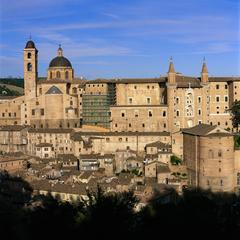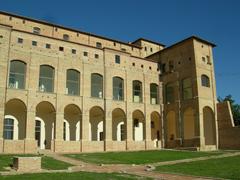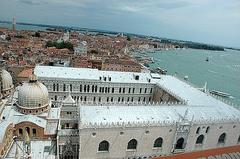
Visiting Palazzo Ducale in Urbino: Tickets, Hours, and History
Date: 17/07/2024
Introduction
Palazzo Ducale in Urbino, Italy, is a remarkable representation of Renaissance architecture and a beacon of cultural and artistic sophistication. Constructed in the mid-15th century, this grand palace was commissioned by Federico da Montefeltro, the Duke of Urbino. It stands as a testament to his vision to create not just a residence, but a symbol of his power and cultural patronage. Designed by renowned architects Luciano Laurana and Francesco di Giorgio Martini, the Palazzo Ducale showcases innovative architectural elements and intricate designs that are emblematic of the Renaissance period (Italy Heritage).
The palace serves as a cultural hub, drawing artists, scholars, and intellectuals from across Europe. It houses the Galleria Nazionale delle Marche, one of Italy’s most important art museums, featuring works by Raphael, Titian, and Piero della Francesca. The Studiolo of Federico da Montefeltro, adorned with intricate woodwork and intarsia panels, reflects the Duke’s dedication to humanist ideals and intellectual pursuits (Britannica, Uffizi).
Whether you’re a history enthusiast or planning your next trip, this guide provides comprehensive details on visiting hours, ticket prices, architectural significance, and travel tips, ensuring a memorable visit to this UNESCO World Heritage Site.
Table of Contents
- Introduction
- Origins and Construction
- Federico da Montefeltro’s Influence
- Architectural Innovations
- Contributions of Francesco di Giorgio Martini
- The Role of Art and Culture
- The Decline and Restoration
- The Galleria Nazionale delle Marche
- The Studiolo of Federico da Montefeltro
- The Influence of Humanism
- Visitor Information
- FAQ
- Conclusion
Explore the Rich History of Palazzo Ducale - Visiting Hours, Tickets, and Cultural Significance
Origins and Construction
The construction of the Palazzo Ducale began in the mid-15th century, around 1454, under the direction of the architect Maso di Bartolomeo. However, it was the arrival of the renowned architect Luciano Laurana in 1466 that marked a significant turning point. Laurana introduced innovative architectural elements, including the majestic courtyard and the intricate façade, which are masterpieces of Renaissance architecture (Italy Heritage).
Federico da Montefeltro’s Influence
Federico da Montefeltro, a prominent condottiero and patron of the arts, played a crucial role in shaping the Palazzo Ducale. His vision was to create a palace that not only served as a residence but also as a symbol of his power and cultural sophistication. The Studiolo, a small study room adorned with intricate intarsia work, is a prime example of Federico’s dedication to the arts and intellectual pursuits (Britannica).
Architectural Innovations
One of the most notable features is the Courtyard of Honor (Cortile d’Onore), a harmonious space surrounded by elegant arcades and columns. Laurana’s use of perspective and proportion in the courtyard’s design exemplifies the principles of Renaissance architecture. Additionally, the palace’s façade, with its symmetrical windows and decorative elements, showcases Laurana’s mastery of classical architectural forms (Italian Ways).
Contributions of Francesco di Giorgio Martini
Following Laurana’s departure in 1472, the architect Francesco di Giorgio Martini took over the project. Martini continued Laurana’s work and introduced his own innovations, including the construction of the palace’s upper floors and the addition of defensive features. Martini’s contributions also extended to the interior, where he designed several rooms and decorative elements that enhanced the palace’s aesthetic and functional qualities (Treccani).
The Role of Art and Culture
The Palazzo Ducale was not only a residence but also a cultural hub that attracted artists, scholars, and intellectuals from across Europe. Renowned artists such as Piero della Francesca, Paolo Uccello, and Justus van Gent were commissioned to create works for the palace, contributing to its reputation as a center of Renaissance art and culture (Uffizi).
The Decline and Restoration
Following the death of Federico da Montefeltro in 1482, the Palazzo Ducale experienced a period of decline. The subsequent rulers of Urbino, including Federico’s son Guidobaldo, faced political and financial challenges that affected the maintenance and preservation of the palace. However, efforts to restore and preserve the Palazzo Ducale began in the 19th century, with significant restoration work carried out in the 20th century. Today, the palace is a UNESCO World Heritage Site and a major tourist attraction, drawing visitors from around the world to admire its architectural and artistic treasures (UNESCO).
The Galleria Nazionale delle Marche
The Palazzo Ducale is home to the Galleria Nazionale delle Marche, one of Italy’s most important art museums. The gallery houses an extensive collection of Renaissance art, including works by Raphael, Titian, and Piero della Francesca. The museum’s collection provides valuable insights into the artistic and cultural achievements of the Renaissance period, further enhancing the historical significance of the Palazzo Ducale (Galleria Nazionale delle Marche).
The Studiolo of Federico da Montefeltro
One of the most remarkable rooms in the Palazzo Ducale is the Studiolo of Federico da Montefeltro. This small study is renowned for its intricate woodwork and intarsia panels, which depict various scenes of classical and contemporary knowledge. The Studiolo reflects Federico’s intellectual pursuits and his dedication to the humanist ideals of the Renaissance. The room’s design and decoration are considered masterpieces of Renaissance art and craftsmanship (Met Museum).
The Influence of Humanism
The design and decoration of the Palazzo Ducale were heavily influenced by the principles of humanism, a cultural and intellectual movement that emphasized the study of classical antiquity and the potential of human achievement. Federico da Montefeltro’s patronage of humanist scholars and artists played a crucial role in shaping the palace’s cultural environment. The integration of classical themes and motifs in the palace’s architecture and decoration reflects the humanist ideals that were central to the Renaissance (Britannica).
Visitor Information
Planning a visit to Palazzo Ducale? Here are some essential details to help you make the most of your trip:
- Visiting Hours: The palace is generally open from 8:30 AM to 7:15 PM, with the last admission at 6:15 PM. Hours may vary on holidays, so it’s advisable to check the official website for the most up-to-date information (Palazzo Ducale Visiting Hours).
- Tickets: General admission tickets are priced at approximately €8, with discounts available for students, seniors, and groups. Children under 18 and residents of Urbino often enjoy free entry. Tickets can be purchased online or at the entrance (Palazzo Ducale Tickets).
- Guided Tours: For a more enriching experience, consider joining a guided tour. These are available in multiple languages and offer deep insights into the history and architecture of the palace.
- Special Events: The Palazzo Ducale frequently hosts special exhibitions, concerts, and cultural events. Check the official website or local listings for current and upcoming events.
- Accessibility: The palace is equipped with facilities to assist visitors with mobility issues. Elevators and ramps are available to ensure that all visitors can enjoy the site (Accessibility Information).
- Nearby Attractions: While in Urbino, don’t miss other historical sites such as the Oratorio di San Giovanni Battista and the birthplace of Raphael. The city itself is a UNESCO World Heritage Site and offers a wealth of cultural and historical experiences.
- Travel Tips: Urbino is easily accessible by bus from nearby cities like Pesaro and Ancona. Consider staying overnight to fully explore the city’s rich history and vibrant culture.
FAQ
Q: What are the visiting hours of Palazzo Ducale? A: The palace is generally open from 8:30 AM to 7:15 PM, with the last admission at 6:15 PM. Hours may vary on holidays, so check the official website for the most current information.
Q: How much do tickets to Palazzo Ducale cost? A: General admission tickets are priced at approximately €8, with discounts available for students, seniors, and groups. Children under 18 and residents of Urbino often enjoy free entry.
Q: Are guided tours available at Palazzo Ducale? A: Yes, guided tours are available in multiple languages and offer deep insights into the history and architecture of the palace.
Q: What are some nearby attractions to Palazzo Ducale? A: While in Urbino, don’t miss other historical sites such as the Oratorio di San Giovanni Battista and the birthplace of Raphael. The city itself is a UNESCO World Heritage Site.
Conclusion
In summary, a visit to Palazzo Ducale in Urbino is not just a journey through the corridors of a grand Renaissance palace, but a deep dive into the rich tapestry of history, art, and culture. From its architectural innovations introduced by Luciano Laurana and Francesco di Giorgio Martini to the cultural patronage of Federico da Montefeltro, the palace stands as a monument to the enduring legacy of the Renaissance. Today, it continues to captivate visitors from around the world, offering insights into the artistic and intellectual achievements of the period.
With its extensive art collections housed in the Galleria Nazionale delle Marche and the meticulously crafted Studiolo of Federico da Montefeltro, the Palazzo Ducale is a treasure trove of Renaissance art and culture. The palace’s status as a UNESCO World Heritage Site underscores its historical and cultural significance, making it a must-visit destination. Plan your visit to explore its architectural and artistic treasures and immerse yourself in the vibrant cultural environment that once attracted the brightest minds of Europe (UNESCO, Galleria Nazionale delle Marche).
References
- Explore the Rich History of Palazzo Ducale - Visiting Hours, Tickets, and Cultural Significance, 2020, Italy Heritage source
- Federico da Montefeltro, 2021, Britannica source
- Piero della Francesca, Uffizi Gallery source
- Palazzo Ducale, UNESCO World Heritage Centre source
- Galleria Nazionale delle Marche, Galleria Nazionale delle Marche source





